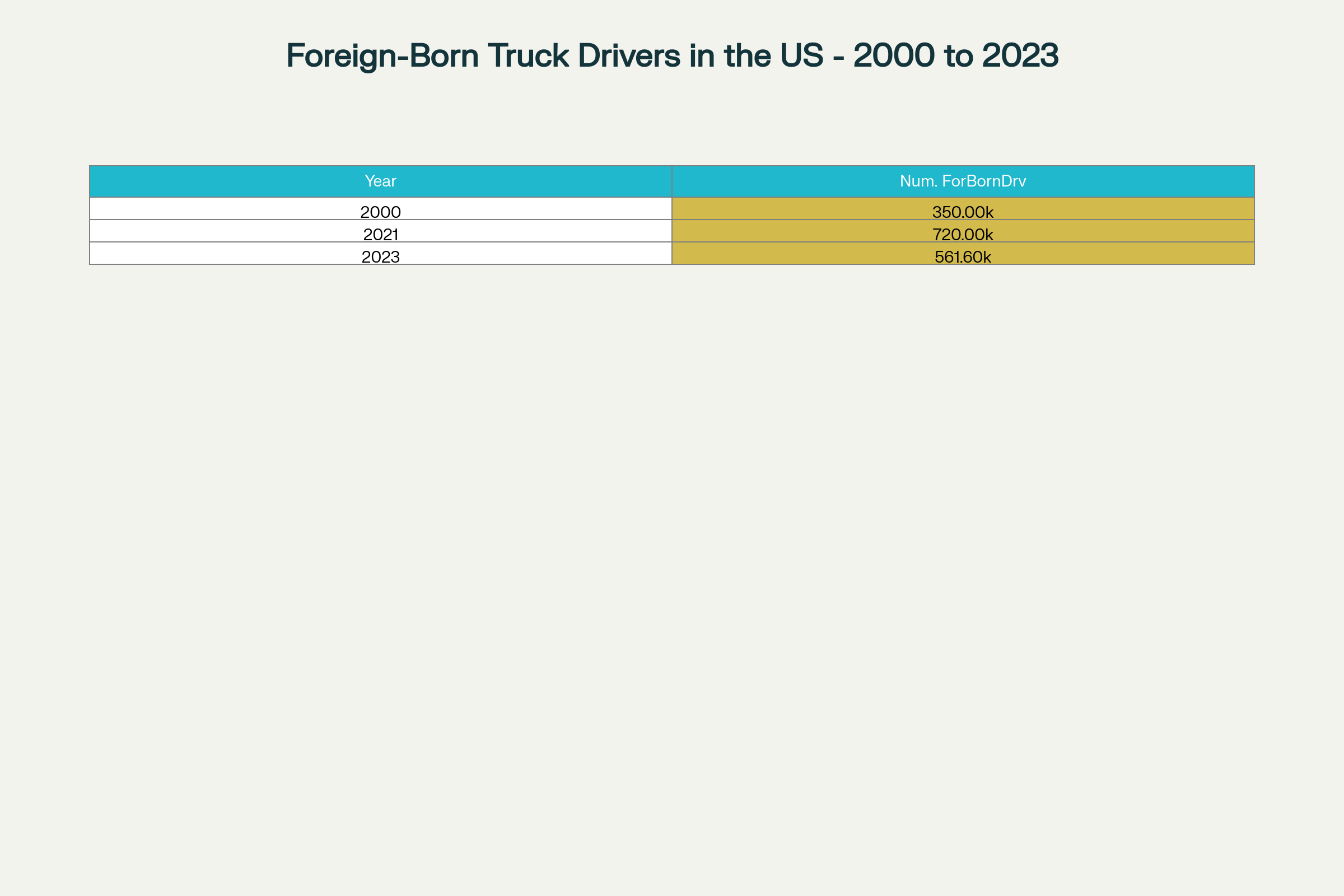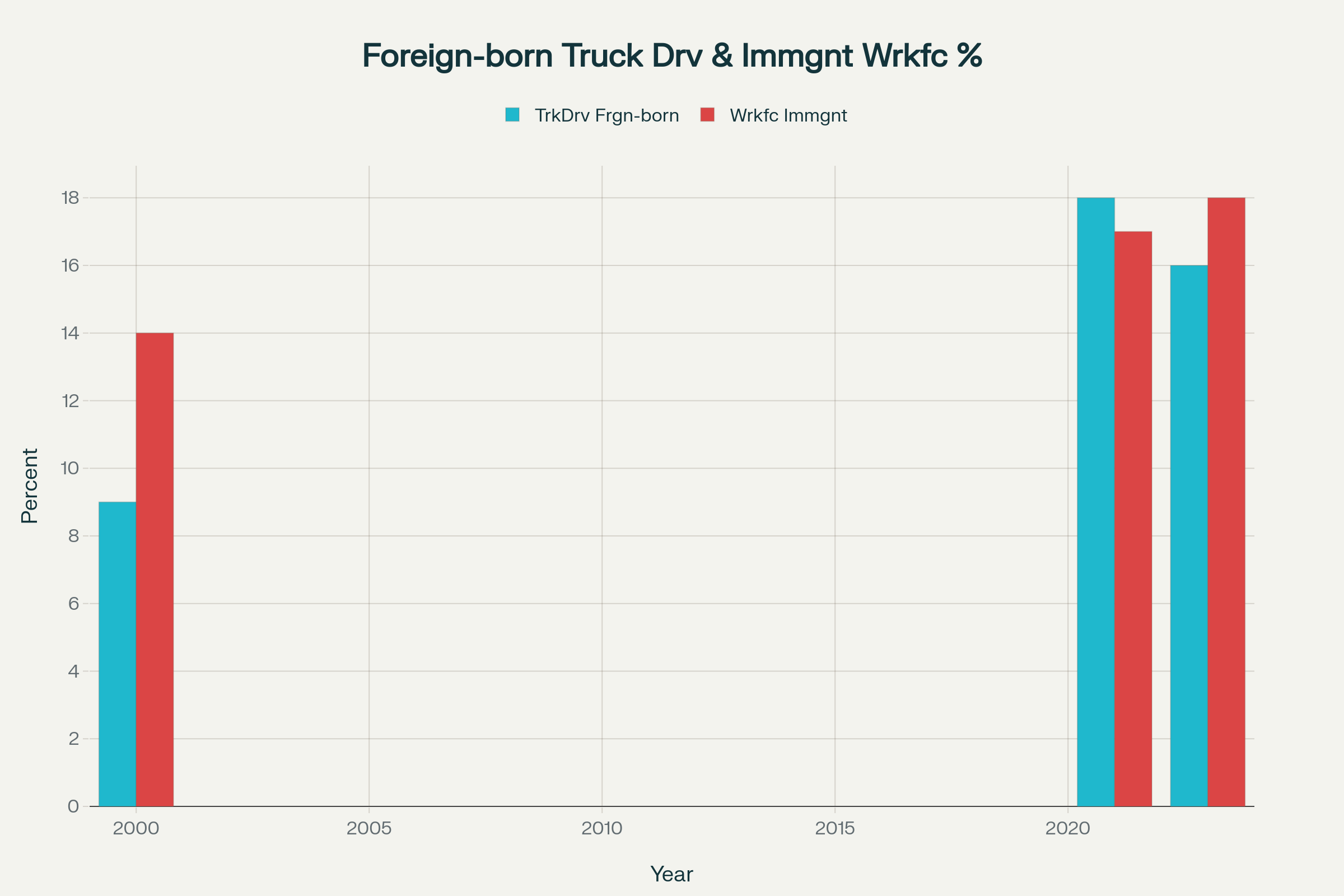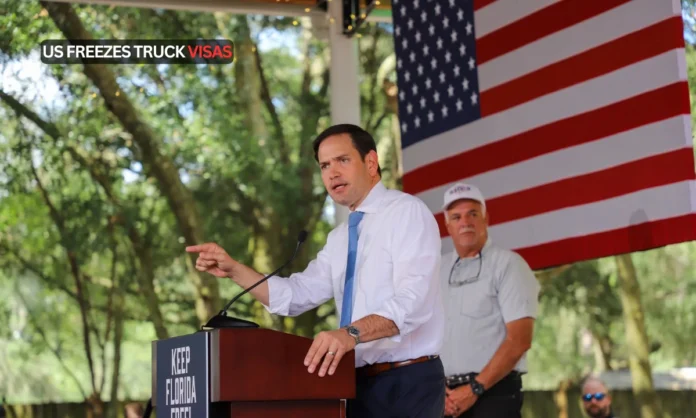Key Highlights:
- Secretary of State Marco Rubio immediately announced that the US pauses visas for foreign truck drivers following a fatal Florida crash involving an Indian driver
- Foreign-born truck drivers compose approximately 16-18% of the US trucking workforce, totaling over 720,000 drivers by 2021
- New English proficiency enforcement rules took effect June 2025, placing drivers out of service for language violations
Initial Context: A Single Crash Triggers Major Policy Shift
The United States has implemented an immediate pause on commercial driver visas following a devastating highway crash in Florida that killed three people. Secretary of State Marco Rubio announced this decision on Thursday, citing escalating safety concerns and economic pressures on American truckers. The announcement that the US pauses visas for foreign truck drivers represents a significant shift in how the Trump administration approaches worker immigration policies.
Effective immediately we are pausing all issuance of worker visas for commercial truck drivers.
— Secretary Marco Rubio (@SecRubio) August 21, 2025
The increasing number of foreign drivers operating large tractor-trailer trucks on U.S. roads is endangering American lives and undercutting the livelihoods of American truckers.
The fatal incident involved Harjinder Singh, an Indian national who allegedly entered the United States illegally from Mexico and failed English proficiency tests after the crash. Singh was charged with three counts of vehicular homicide after attempting an illegal U-turn on a Florida highway, according to federal officials. The case has become a political flashpoint, with California issuing Singh’s commercial license while the federal government had approved his work permit. This tragic event has fundamentally altered the landscape after the US pauses visas for foreign truck drivers and raised questions about driver qualification standards across the industry.
The decision that the US pauses visas for foreign truck drivers affects multiple visa categories including H-2B, E-2, and EB-3 classifications, applying to all nationalities rather than targeting specific countries. Federal officials emphasized that the pause enables “comprehensive and thorough review of screening and vetting protocols used to determine their qualifications for a U.S. visa”. This comprehensive review comes as the trucking industry faces an estimated shortage of 60,000 to 78,000 drivers according to the American Trucking Associations.
Federal Statistics Reveal Growing Foreign Driver Workforce
The trucking industry’s reliance on foreign workers has expanded dramatically over the past two decades. Official federal statistics show that foreign-born truck drivers in the United States more than doubled between 2000 and 2021, reaching 720,000 drivers. This growth reflects the industry’s response to persistent labor shortages and increasing freight demand, making the decision that the US pauses visas for foreign truck drivers particularly significant.
- Foreign-born drivers now represent approximately 16-18% of the total trucking workforce as of 2023
- The percentage aligns with broader US labor market demographics but marks a significant shift for a traditionally American profession

Number of Foreign-Born Truck Drivers in the US from 2000 to 2023 based on federal statistics
Current workforce data indicates that more than half of foreign-born drivers originate from Latin America, with substantial numbers coming from India and Eastern European nations, particularly Ukraine. The visa program has become essential for addressing critical labor gaps, with industry experts estimating a shortage of 24,000 truck drivers nationwide, costing the freight industry $95.5 million weekly in undelivered goods. However, now that the US pauses visas for foreign truck drivers, these existing workforce challenges could become significantly worse and create substantial supply chain disruptions across multiple sectors.
The Federal Motor Carrier Safety Administration’s 2023 demographic study reveals that approximately 16% of US truck drivers were foreign-born as of 2023. This data becomes particularly relevant as the US pauses visas for foreign truck drivers policy takes effect, potentially reducing the pipeline of new international drivers entering the workforce.
New English Proficiency Rules Reshape Driver Requirements
The Trump administration implemented stringent English proficiency enforcement beginning June 25, 2025, fundamentally changing how foreign driver visa holders must demonstrate language skills. Transportation Secretary Sean Duffy reversed Obama-era guidance that had relaxed enforcement of English language proficiency requirements for commercial drivers. Under the new regulations, drivers who cannot adequately demonstrate English skills during roadside inspections face immediate out-of-service placement, making the announcement that the US pauses visas for foreign truck drivers part of a broader enforcement strategy.
- Commercial drivers must read and understand traffic signs, communicate with safety officers, and complete reports in English
- The Commercial Vehicle Safety Alliance updated enforcement guidelines to include English proficiency violations in out-of-service criteria
- Emergency rule implementation allowed rapid deployment to meet the 60-day executive order deadline
The Federal Motor Carrier Safety Administration’s longstanding regulations require commercial motor vehicle drivers to sufficiently read, speak, and understand English. However, the 2016 Obama administration guidance directed inspectors not to remove drivers from service solely for language deficiencies. Secretary Duffy emphasized that inadequate enforcement of driver qualification standards increases crash risks and compromises highway safety. These enhanced requirements work in conjunction with the policy that the US pauses visas for foreign truck drivers, creating additional barriers for international drivers seeking employment in the US trucking sector.

Department of Labor H-2B visa certifications show just over one hundred granted to “commercial truck drivers” annually, with estimates ranging from 1,000 to 1,490 H-2B visas issued for foreign truckers each year. While these numbers seem modest compared to the overall workforce, the decision that the US pauses visas for foreign truck drivers affects the industry’s ability to recruit qualified international talent during critical labor shortages.
Industry Impact and Political Ramifications of Visa Suspension
The suspension creates immediate workforce implications for an industry already struggling with driver shortages. Rubio stated that the increasing number of foreign drivers operating tractor-trailers “endangers American lives and undercuts the livelihoods of American truckers”. The announcement that the US pauses visas for foreign truck drivers generated significant political attention, particularly affecting Indian-American trucking communities that have filled vital roles amid persistent labor shortages.
The truck driver who made an illegal U-turn on Florida's Turnpike that led to the passing of 3 Americans, illegally entered the U.S. through the southern border in 2018.
— Collin Rugg (@CollinRugg) August 17, 2025
Harjinder Singh has been charged with three counts of vehicular homic*de.
Singh got his Commercial Driver’s… pic.twitter.com/FGZVHDWMGs
- California alone houses tens of thousands of truckers with Indian heritage, many from Sikh communities
- These communities operate trucking businesses, training schools, truck stops, and supportive infrastructure facilities
- Immigration attorneys warn the policy could fuel negative stereotyping and bias against all Indian truckers regardless of legal status
The decision that the US pauses visas for foreign truck drivers coincides with broader immigration enforcement efforts under the Trump administration. Republican lawmakers have increasingly targeted foreign truckers, pointing to crash statistics without establishing direct causal links to immigrant drivers. The Department of Homeland Security had previously announced plans to offer 64,716 additional H-2B visas for fiscal year 2025, specifically targeting returning workers and applicants from Latin American and Caribbean countries. However, the recent policy that the US pauses visas for foreign truck drivers represents a complete reversal of these expansion plans and signals stricter immigration policies ahead.
Industry groups support enhanced scrutiny of visa applicants while emphasizing the need for qualified drivers. The American Trucking Associations backs tighter screening processes, including enforcement of entry-level training standards, but warns that overly restrictive policies could exacerbate existing labor shortages. The fact that the US pauses visas for foreign truck drivers creates tension between safety concerns and practical workforce needs in an already constrained labor market.
Closing Assessment: Long-term Consequences for Transportation Industry
The immediate decision that the US pauses visas for foreign truck drivers marks a watershed moment for American transportation policy and immigration enforcement. While the administration frames this decision as necessary for highway safety and American worker protection, the policy creates significant challenges for an industry dependent on foreign labor to meet freight demands. The enhanced English proficiency requirements, combined with the visa suspension, will likely reshape the demographic composition of America’s trucking workforce.
Industry stakeholders now face the dual challenge of maintaining freight operations while adapting to stricter qualification standards and reduced foreign worker access. The policy that the US pauses visas for foreign truck drivers may force employers to invest more heavily in domestic driver recruitment and training programs, potentially increasing operational costs and delivery timelines. As enforcement agencies implement these new policies, the long-term success will depend on balancing legitimate safety concerns with the practical realities of maintaining America’s critical freight infrastructure through adequate driver availability and workforce diversity.
The suspension remains in effect indefinitely, with State Department officials indicating that comprehensive reviews of screening protocols will determine when or if the US pauses visas for foreign truck drivers policy might be modified or lifted. This uncertainty creates additional challenges for logistics companies and freight operators who must now navigate reduced access to international talent while meeting growing transportation demands across the American economy.


